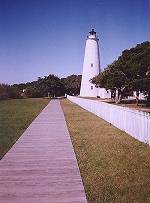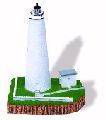 |
Built: 1823
Type: Conical Tower
Height: 65 feet
Status: Active
Location: Ocracoke Island
Lens: Originally an oil burning light - 1854 Fourth Order Fresnel
Keepers:
Notes: Ocracoke Inlet was
first put on the map when English explorers wrecked a sailing ship there
in 1585. Two centuries later this was one of the busiest inlets on the
East Coast. Ocracoke Inlet was the only reasonably navigable waterway for
ships accessing inland ports such as Elizabeth City, New Bern, and Edenton.
Ocracoke Village, then known as Pilot Town, developed as a result
of the inlet's use. Pilots hired to steer ships safely through the shifting
channels to mainland ports settled the village in the 1730's.
By 1718, Blackbeard had
come to regard Ocracoke as his favorite anchorage. He even reportedly had
a house on the island, which he intended to use as a sort of pirate haven.
The coastal citizens, understandably unenthusiastic about the prospect,
bypassed their useless Governor Eden and appealed instead to Governor Spotswood
of Virginia. Help came in the doughty figure of Lieutenant Robert Maynard
of the Royal navy, who brought with him two small sloops. Conflicting reports
survive as to the beginning of the battle; some say Blackbeard fired on
the two small boats Maynard sent to scout out his quarry. A more intriguing,
though probably less reliable, legend claims that Blackbeard, knowing the
sloops were nearby and eager to engage them in battle, spent the night
before the fight impatiently crying out "O crow, cock! O crow, cock!" from
where the inlet got its name.
The U.S. Lighthouse Service
recognized that a lighthouse was needed at Ocracoke Inlet to assist mariners.
In 1794, construction began on Shell Castle Island, a 25 acre, shell-covered
island located between Ocracoke and Portsmouth Island to the south. This
site was adjacent to the deepest inlet channel between shallow Pamlico
Sound and the ocean. The wooden, pyramid- shaped tower was completed four
years later. Nearby on the island, a small light keeper's house was built
along with several cargo wharves, gristmills, houses, and other facilities.
The lighthouse, a great
blessing to mariners, was obsolete in less than 30 years due to migration
of the main channel. By 1818, the channel had shifted nearly a mile away.
That same year, both the lighthouse and keeper's house were destroyed by
lightning.
In 1822, for a charge of
$50, the federal government purchased two acres at the south end of Ocracoke
Island as the site for a new lighthouse. Constructed by Massachu- setts's
builder Noah Porter and finished in 1823, the tower still stands today.
Total cost, including the one story, one bedroom light keeper's house,
was $11,359, far below the $20,000 budgeted.
The lighthouse stands 75
feet tall. Its diameter narrows from 25 feet at the base to 12 feet at
its peak. The walls are solid brick - 12 feet thick at the bottom tapering
to two feet at the top. An octagonal lantern crowns the tower and houses
the light beacon.
The exterior's solid white
coloration serves as its identifying mark to mariners by day. The original
whitewash "recipe" called for blending lime, salt, spanish whiting, rice,
glue and boiling water. The mixture was applied while still hot.
A fourth-order Fresnel lens
was installed in 1854, replacing the old reflector system. Its hand-cut
prisms and magnifying glass greatly intensified the light. Early in the
Civil War the lens was dismantled by the Confederates but re-installed
in 1864 by Union forces. Originally an oil-burning light, the Ocracoke
Light was electrified in the early decades of the 1900's. The present light
is equal to 8,000 candlepower and casts a stationary beam that can be seen
14 miles at sea. A battery powered back-up light operates during power
failures.
As duties at the light station
increased, an assistant keeper position was established. To house the additional
keeper and his family, a second story was built onto the original quarters
in 1897 and another section was added in 1929. The double keepers' quarters
still stand on the site today, along with a generator house, once the oil
supply shed.
During hurricanes the light
station served as a place of refuge for some local residents. Situated
on higher ground, the complex often remained above flood waters. Villagers,
sometimes arriving by boats which navigated inundated roadways, waited
out the storm in the keepers' home. Fully automated, the lighthouse no
longer needs a resident light keeper to tend to its daily needs. The United
States Coast Guard now oversees its operation.
The Ocracoke light is the
second oldest operating lighthouse in the nation. The lighthouse
survived the Civil War with minimal damage; Confederate troops dismantled
the fourth-order Fresnel lens early on, but in 1864 Union forces re-installed
it. In the early 1900's it was electrified, and today the lighthouse casts
a stationary beam visible for fourteen miles.
| Ocracoke
- NC
Scaasis Sculpture
|
North
Carolina Throws
|
Ocracoke
- NC
Lefton Sculpture
|
|||
| You Can Now | Copyright | Credits |
| Contact Us | usalights Store | Shopping Center |



